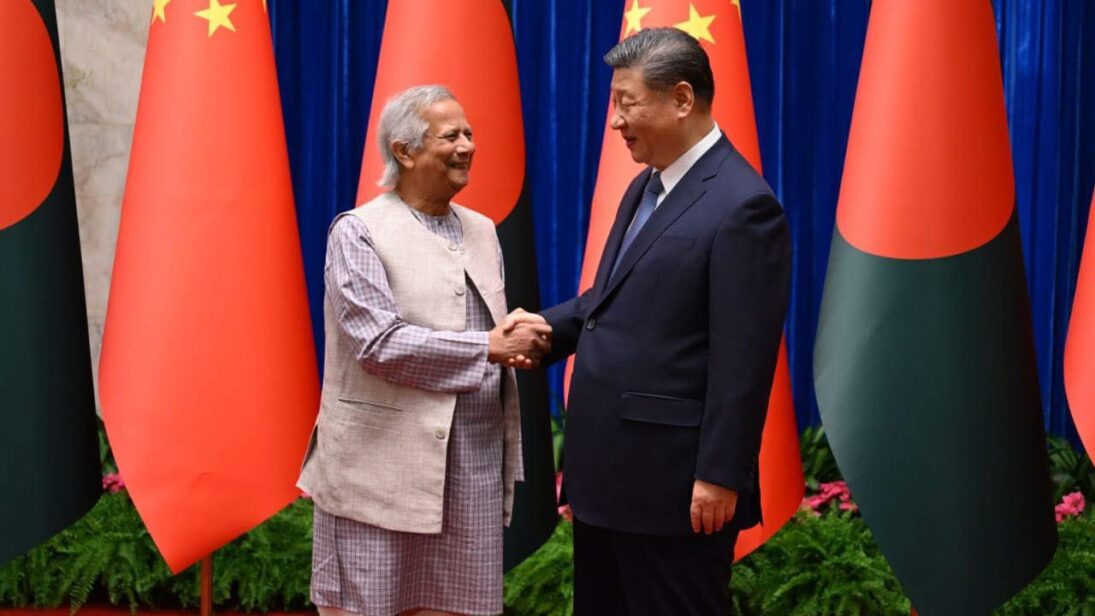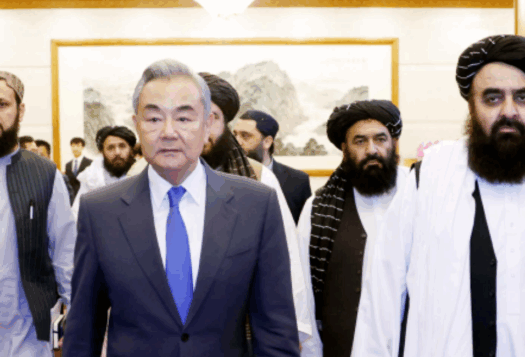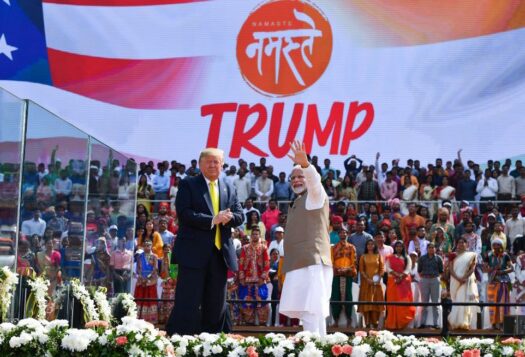
After former Bangladeshi Prime Minister Sheikh Hasina’s deposition last summer, the country has been revamping its connections with many partners; the most intriguing of these interactions are with Pakistan and China. The recent warming of Pakistan-Bangladesh relations and Bangladesh Chief Adviser Muhammad Yunus’s visit to China suggest that the South Asian political strategic landscape is undergoing subtle yet important changes. While a formal triangular relationship among them does not yet exist, deepening bilateral engagements between Dhaka and Beijing and the emerging rapprochement between Dhaka and Islamabad can lead to a potential convergence that may challenge the regional strategic status quo, placing India in a complex strategic dilemma.
Bangladesh-Pakistan-China: Historical Lows and Recent Highs
Hasina’s regime, which lasted almost fifteen years, was oriented towards India, with implications for China and Pakistan. Under Hasina, the relationship with Pakistan continued to be marked by distrust and unresolved historical grievances since the bitter split in 1971. Meanwhile, in approaching the relationships with India and China, Hasina practiced a nuanced foreign policy of hedging—maintaining close security and political ties with New Delhi while leveraging Beijing for economic growth and infrastructure development. However, since Hasina’s ouster, under Yunus’s interim government, Bangladesh’s policy towards its immediate neighbors has changed, entering a new phase where Dhaka appears willing to move closer to Islamabad and Beijing to secure its developmental and diplomatic interests, even at the risk of unsettling its relationship with New Delhi.
Deepening bilateral engagements between Dhaka and Beijing and the emerging rapprochement between Dhaka and Islamabad can lead to a potential convergence that may challenge the regional strategic status quo, placing India in a complex strategic dilemma.
Since August 2024, there have been numerous diplomatic exchanges between Bangladesh and Pakistan, such as Yunus’ meetings with Pakistani Prime Minister Shehbaz Sharif at various multilateral fora. Beyond leadership-level talks, ministerial interactions have also deepened. An upcoming visit by Deputy Prime Minister and Foreign Minister Ishaq Dar will be the first expected ministerial visit from Pakistan to Dhaka in the last 13 years, indicating eagerness from both sides to deepen ties. Moreover, there is also a nascent but budding Bangladesh-Pakistan military relationship, with a high-level Bangladeshi military delegation traveling to Pakistan in January to hold talks with Pakistani Chief of Army Staff General Asim Munir. A recent example of increasing military engagement between the two was the Bangladesh navy’s participation in Pakistan’s multinational maritime exercise, Aman-25, after a gap of more than 10 years.
This shift extends to commercial ties; after a long time, Bangladesh and Pakistan have resumed direct trade. Dhaka imported 50,000 tons of rice from Pakistan in February, direct flights have resumed, and both countries have simplified visa procedures to facilitate people-to-people exchange. Between November and December 2024, Pakistani ships delivered over 1,000 containers of goods to the port of Chittagong. Though still early, this rapprochement signals a significant break from the past and could form one leg of an emerging regional triangle, especially with deepening Dhaka-Beijing ties.
Meanwhile, Bangladesh’s China policy under Yunus no longer seems to be defined by his predecessor’s cautious balancing act, but increasingly appears to be closer to alignment. Yunus’s state visit to China in March was indicative of this transition. His visit sent a signal that China remains central to Bangladesh’s external engagement, perhaps more so than ever before. For its part, Beijing has promptly enhanced relations with the new caretaker administration in Dhaka, finalizing new pacts and showcasing soft power via scholarships, cultural initiatives, and development support.
The centerpiece of this evolving partnership is the further expansion of the China Industrial Economic Zone in Chattogram and proposed Chinese involvement in the Mongla Port modernization, which would reinforce Beijing’s position as Bangladesh’s principal economic partner. Moreover, Dhaka inviting Chinese involvement in the Teesta River project, which has long been a point of friction between India and Bangladesh, not only indicates frustration with Indian delays but also reveals a growing confidence in China’s ability to deliver on sensitive infrastructure projects. While many of the agreements build upon those from Hasina’s 2024 visit, the political transition in Bangladesh has moved the relationship closer to strategic alignment. Amid a more complex domestic and regional environment, Dhaka’s access to duty-free Chinese goods, the deepening of cultural and educational exchanges, and Beijing’s assistance in water management and disaster mitigation all reflect an expanding bilateral partnership beyond trade and infrastructure.

China in South Asia: A New Regional Order?
In this regard, the Pakistan-Bangladesh thaw aligns with China’s regional goals, as strengthened connections among its South Asian partners would boost regional connectivity. Simultaneously, it could reduce India’s strategic influence in future if trade can happen by expanding Chinese access to Bangladeshi ports and facilitating overland or maritime trade linkages between Pakistan and Bangladesh through China. China persistently broadens its influence in South Asia, propelled by economic statecraft, defense diplomacy, and strategic partnerships, putting increasing pressure on India’s neighborhood strategy. In the medium to long run, this developing triangular alignment could establish China as a key player in South Asian geopolitics, promoting its vision of a multipolar China-led regional structure rooted in development and collaborative security frameworks.
China has already made several efforts in this regard in recent years. For instance, in 2020, Beijing convened a quadrilateral dialogue with Nepal, Pakistan, and Afghanistan to discuss regional matters, including connectivity. In future, China could expand this dialogue to include Bangladesh, Myanmar, and potentially Bhutan, all countries it has expanding ties with, while excluding India. China could also envision boosting the trans-Himalayan corridor, and the Bay of Bengal maritime corridor connecting Chittagong to Gwadar, while undermining regional integration projects in Northeast India such as the under-construction India-Myanmar-Thailand Trilateral Highway. Amid shifting dynamics in South Asia, Bangladesh’s evolving ties with Pakistan and China signal a potential regional realignment, opening the door to China’s reshaping of the regional order and challenging India’s influence.
New Delhi finds itself caught between the urge to defend long-nurtured bilateral ties and the necessity of revamping its approach to an increasingly volatile neighbor. Yunus’s provocative remarks in China about Northeast India being landlocked and Bangladesh as “the only guardian of the ocean for all in this region” as well as the speculation of Beijing planning to build an airfield in Bangladesh’s Lalmonirhat district have raised alarm and suspicion in New Delhi. If the project materializes, it would be a direct threat to India’s core national security interests as the region lies close to the narrow and strategically sensitive Siliguri Corridor, also known as India’s Chicken’s Neck, which links mainland India with the Northeast.
These challenges are further heightened by growing strains in India-Bangladesh ties. The Modi government has so far withheld proactive diplomatic outreach to Yunus, apart from their recent meeting on the sidelines of the BIMSTEC summit held in Thailand. Additionally, delays in water-sharing agreements and cross-border infrastructure projects have fueled perceptions of Indian indifference. In contrast, China’s swift response, flexible financing terms, and willingness to engage on sensitive issues like Rohingya repatriation and the need for peace talks in Myanmar suggest a partnership that is not only economic but increasingly strategic.
Amid shifting dynamics in South Asia, Bangladesh’s evolving ties with Pakistan and China signal a potential regional realignment, opening the door to China’s reshaping of the regional order and challenging India’s influence.
Bangladesh’s newfound alignment with China could also have real strategic consequences for India in the diplomatic sphere. If Dhaka aligns more closely with Beijing’s positions at multilateral fora like the UN on issues sensitive to India (e.g., the Kashmir dispute, minority rights, or Indo-Pacific strategy), as Pakistan has done, it could erode India’s diplomatic space. Bangladesh’s support for China-led narratives could blunt India’s ability to present a unified South Asian stance in global fora, especially if other regional states follow suit. Beyond physical bypassing, if Bangladesh and Pakistan become hubs for Chinese digital and logistics corridors leveraging Chinese fintech, e-commerce, and customs technologies, India’s efforts like the India-Myanmar-Thailand trilateral highway or BIMSTEC could lose traction. This fragmentation of South Asia into separate China-aligned economic zones could reduce India’s centrality in regional integration efforts.
Meanwhile, Bangladesh’s increased security ties with Pakistan pose a more straightforward military concern for New Delhi. The border between India and Bangladesh has historically been unsecured, allowing insurgent groups to travel back and forth between the two countries. While Hasina’s Awami League government had taken steps to crack down on these groups, there is a renewed fear in New Delhi that a Bangladesh-Pakistan rapprochement could revive this problem.
It must be acknowledged that despite the current diplomatic push, questions remain about the sustainability of this nascent Pakistan-Bangladesh rapprochement. It is yet to be seen whether these efforts can withstand the enduring influence of India’s trade volume and geographic proximity. In addition, the current bonhomie is steered by the interim setup in Bangladesh, which is supposed to transfer power to an elected government over the next year and it is too early to speculate whether this engagement will continue. Overall, however, even while the relationship is still in its early stages, the concurrent strengthening of Dhaka’s bilateral ties with Beijing and Islamabad points to a change in the regional order away from India’s predominance and opens up pathways for unconventional alignments and linkages in the future.
Views expressed are the author’s own and do not necessarily reflect the positions of South Asian Voices, the Stimson Center, or our supporters.
Also Read: What Evolving Pak-Bangla Relations Mean for Southern Asia
***
Image 1: Chief Adviser of the Government of Bangladesh via X
Image 2: Salim_Khandoker via Wikimedia Commons


